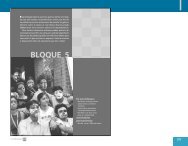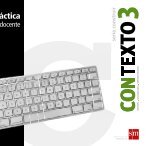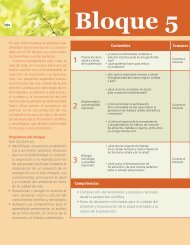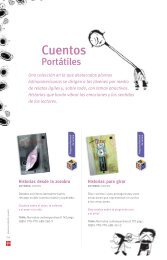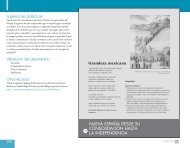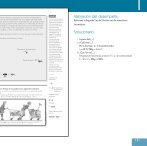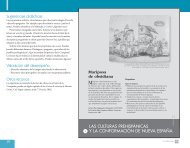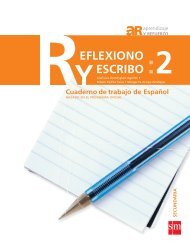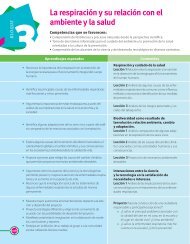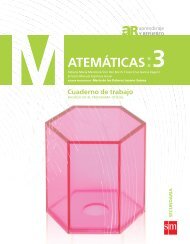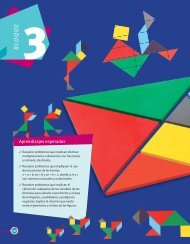Unit 2 - Secundaria SM
Unit 2 - Secundaria SM
Unit 2 - Secundaria SM
You also want an ePaper? Increase the reach of your titles
YUMPU automatically turns print PDFs into web optimized ePapers that Google loves.
3<br />
4<br />
<br />
<br />
<br />
<br />
<br />
<br />
2 Think about it!<br />
a. Look at Track 17 on page 211 and underline<br />
the sentences Nick uses to explain the rules.<br />
b. Answer the questions.<br />
1. How is the way that Nick explains the rules diff erent<br />
to how they appear in the pamphlet?<br />
2. What words does Nick use that are not in the pamphlet?<br />
c. Work in pairs. Discuss your answers.<br />
3 Try it out!<br />
a. Read the pamphlet and complete the dialogue.<br />
4 Use it!<br />
<br />
<br />
<br />
Go to page<br />
206<br />
<br />
<br />
<br />
<br />
Man: Where are you going?<br />
Boy: The swimming pool.<br />
Man: Great! Remember you 1)<br />
other people.<br />
Boy: OK.<br />
mustn’t run or push<br />
Man: You 2) must obey the rules of the pool and you<br />
3) mustn’t<br />
swim if there isn’t a lifeguard.<br />
Boy: OK. See you later.<br />
Man: Bye. Be careful!<br />
a. Work in pairs. Make a safety pamphlet.<br />
• Think of an activity that can be dangerous: skateboarding,<br />
rollerblading, rappeling, horseback riding, etc.<br />
• Make a list of rules to help avoid accidents and to make<br />
the activity safer.<br />
• Make a safety pamphlet with your rules. Include simple<br />
drawings.<br />
b. Work in groups. Present your pamphlet to another pair. Tell<br />
them what they must do to stay safe.<br />
<strong>Unit</strong> 2 Lesson 14<br />
79<br />
2 Think about it!<br />
a. Pida a los alumnos que lean la transcripción del Track 17 en<br />
la página 211 y que subrayen las oraciones que Nick usa para<br />
explicar las reglas.<br />
b. Solicite a los alumnos que contesten las preguntas.<br />
c. Divida la clase en parejas. Pida a los alumnos que comenten<br />
sus repuestas.<br />
Cerciórese de que los alumnos comprenden que el verbo<br />
auxiliar must siempre se usa con la forma simple del<br />
verbo principal: You must wear a helmet, y que su forma<br />
negativa es must not o mustn’t: You mustn’t overtake cars.<br />
3 Try it out!<br />
a. Pida a los alumnos que lean el folleto y completen el diálogo.<br />
4 Use it!<br />
a. Divida la clase en parejas. Solicite a los alumnos que elaboren<br />
un folleto con medidas de seguridad para alguna actividad<br />
que puede ser peligrosa: patinar, montar a caballo, etc. Pida<br />
que hagan una lista de reglas que ayuden a evitar accidentes<br />
y a hacer más segura la actividad y que ilustren el folleto con<br />
dibujos simples.<br />
b. Divida la clase en grupos integrados por dos parejas. Pida<br />
a los alumnos que presenten su folleto a la otra pareja y que<br />
le digan qué debe hacer para mantenerse a salvo.<br />
Para concluir…<br />
Divida la clase en grupos. Solicite a los alumnos que doblen<br />
una hoja de papel en tres partes iguales y que hagan<br />
un tríptico con instrucciones para andar en patineta con<br />
seguridad. Pida que usen el folleto de la lección como modelo.<br />
Invítelos a usar sus diccionarios. Luego, pida a los equipos que<br />
presenten sus folletos al resto de la clase.<br />
<strong>Unit</strong> 2 Lesson 14<br />
79



